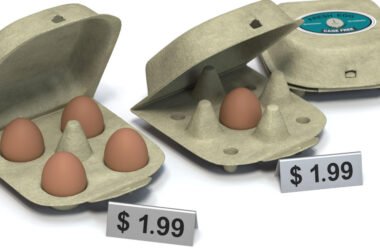Robert Lanter lives in a 600-square-foot home that may be traversed in 5 seconds and vacuumed from a single outlet. He doesn’t have a espresso desk in the lounge as a result of it could impede the entrance door. When family members come to go to, Mr. Lanter says jokingly, however solely partly, they should tour one at time.
Every of those particulars quantities to one thing larger, for Mr. Lanter’s life and the U.S. housing market: a home underneath $300,000, one thing increasingly hard to find. That value allowed Mr. Lanter, a 63-year-old retired nurse, to purchase a brand new single-family dwelling in a subdivision in Redmond, Ore., about half-hour outdoors Bend, the place he’s from and which is, together with its surrounding space, considered one of Oregon’s most costly housing markets.
Mr. Lanter’s home might simply match on a flatbed truck, and is dwarfed by the two-story suburban houses that prevail on the blocks round him. However, the truth is, there are even smaller houses in his subdivision, Cinder Butte, which was developed by an area builder known as Hayden Properties. A few of his neighbors dwell in homes that complete simply 400 sq. toes — a 20-by-20-foot home connected to a 20-by-20-foot storage.
This isn’t a colony of “tiny homes,” well-liked amongst minimalists and aesthetes trying to simplify their lives. For Mr. Lanter and his neighbors, it’s an opportunity to carry on to possession.
Mr. Lanter, who’s not too long ago divorced, got here again to central Oregon from a condominium in Portland solely to find that dwelling costs had surged past his attain. He has owned a number of bigger houses through the years and mentioned he started his latest search on the lookout for a three-bedroom home.
“I didn’t wish to hire,” he mentioned after a five-minute tour of his “media room” (a small desk with a laptop computer) and bed room (barely matches a queen). After being an proprietor for 40 years, the thought of being a tenant felt like a backslide.
And after residing on the seventeenth ground of a Portland condominium, he had dominated out connected and high-rise buildings, which he described as a sequence of guidelines and awkward interactions that made him really feel as if he by no means actually owned the place.
There was the time he bought a settee and the entrance desk attendant scolded him for transferring it down the elevator with out alerting administration a day upfront. Or the occasions he got here dwelling to seek out somebody parked within the spot he owned and paid property taxes on. Attempt to think about a random driver parking in a home’s driveway, he mentioned — there’s no means.
A single-family dwelling means “much less folks’s arms in your life,” Mr. Lanter mentioned.
He needed the 4 unshared partitions of the American idyll, even when these partitions had minimal house between them and had been a sofa size from his neighbor.
A Probability at Possession
A number of colliding tendencies — financial, demographic and regulatory — have made smaller items like Mr. Lanter’s the way forward for American housing, or at the least a extra vital a part of it. Over the previous decade, as the price of housing exploded, dwelling builders have methodically nipped their dwellings to maintain costs in attain of consumers. The downsizing accelerated final 12 months, when the rate of interest on a 30-year mounted charge mortgage reached a two-decade excessive, simply shy of 8 p.c.
Mortgage charges have fallen since, and gross sales, particularly of recent houses, are starting to thaw from the anemic tempo of final 12 months. Even so, a transfer towards smaller, inexpensive houses — in some circumstances smaller than a studio house — appears poised to outlast the mortgage spike, reshaping the housing marketplace for years to come back and altering notions of what a middle-class life appears like.
“That is the entrance finish of what we’re going to see,” mentioned Ken Perlman, a managing principal at John Burns Analysis and Consulting.
Extraordinarily small houses have lengthy been an object of curiosity and fodder for internet content; their tight proportions appear to say massive issues about their occupants. On social media and blogs, influencers swipe at American gluttony and extol the virtues of a life with much less carbon and muddle than the usual two-car suburb.
Now, in the identical means décor tendencies make their means from design magazines to Ikea, mini houses are exhibiting up within the sorts of subdivisions and exurbs the place consumers used to journey for optimum house.
The shift is a response to circumstances which are present in cities throughout America: Neighborhoods that was once inexpensive are being gentrified, whereas new condominiums and subdivisions principally goal the higher finish of the market, endangering the provision of “starter houses” in attain of first-time consumers. That builders are addressing this conundrum with very small houses could possibly be seen as yet one more instance of middle-class diminishment. However consumers say it has helped them get on the primary rung of the housing market.
“They need to assist out extra folks which are younger like us to purchase homes,” mentioned Caleb Rodriguez, a 22-year-old in San Antonio.
Mr. Rodriguez not too long ago moved into a brand new group outdoors San Antonio known as Elm Trails, which was developed by Lennar Company, one of many nation’s largest homebuilders. His home sits in a line of mini dwellings, the smallest of which is simply 350 sq. toes.
On a latest night after work, neighbors had been strolling canines and chatting alongside a row of beige, grey and olive-green two-story houses of the identical form. The event has a pond the place residents picnic and catch bass and catfish. The homes should not have garages, and their driveways are vast sufficient for one car or two bikes — proportions that pushed the sale costs to effectively underneath $200,000.
“I needed to personal, and this was the most cost effective I might get,” mentioned Mr. Rodriguez, who moved on this month and works at a poultry processing plant in close by Seguin, Texas. He paid $145,000 and hopes the home could be a step towards wealth constructing. Possibly in a couple of years he’ll transfer and hire it out, Mr. Rodriguez mentioned.
Properties underneath 500 sq. toes will not be taking up anytime quickly: They’re lower than 1 p.c of the brand new houses inbuilt America, in accordance with Zonda, a housing information and consulting agency. Even Mr. Lanter, who evangelizes about his newly low heating invoice and the liberty of shedding stuff, mentioned he would have most well-liked one thing larger, round 800 sq. toes, if he might discover it.
Whereas these ground plans may be an edge-case providing reserved for sure sorts of consumers — “Divorced … divorced … actually divorced,” Mr. Lanter mentioned as he pointed to the small houses round him — they’re a part of a transparent pattern. Numerous surveys from personal consultants and organizations just like the Nationwide Affiliation of Residence Builders, together with interviews with architects and builders, all present a push towards a lot smaller designs.
“Their existence is telling,” mentioned Ali Wolf, chief economist of Zonda. “All of the uncertainty over the previous few years has simply strengthened the will for homeownership, however land and materials costs have gone up an excessive amount of. So one thing has to present, and what builders are doing now could be testing the market and asking what’s going to work.”
Builders are substituting aspect yards for backyards, kitchen bars for eating rooms. Suburban neighborhoods have seen a increase in adjoined townhouses, together with small-lot single household houses that always have shared yards and no quite a lot of toes between them — a type of mash-up of the suburb and the city rowhouse.
The good compression is being inspired by state and native governments. To cut back housing prices, or at the least hold them from rising so quick, governments across the nation have handed lots of of recent payments that make it simpler for builders to erect smaller items at larger densities. Some cities and states — like Oregon — have basically banned single-family zoning guidelines that for generations outlined the suburban type.
These new guidelines have been rolled out regularly over years and with various levels of effectiveness. What has modified not too long ago is that builders are way more prepared to push smaller dwellings as a result of they haven’t any different technique to attain a big swath of consumers.
“There’s a market alternative and individuals are utilizing it,” mentioned Michael Andersen, a senior researcher at Sightline Institute, a Seattle assume tank targeted on housing and sustainability.
A Massive Home on a Little Lot
American houses have lengthy been bigger on common than these in different developed nations. For many of the previous century, the nation’s urge for food for dimension has solely grown.
The enduring Cape Cods in Levittown, N.Y. — typically thought-about the mannequin post-World Conflict II suburb — had been usually about 750 sq. toes, roomy for a one-bedroom house however small for a free-standing home with two bedrooms. At the moment, although, the median American dwelling dimension is about 2,200 square feet, up from round 1,500 in the 1960s. Lot sizes have remained roughly the identical, which suggests the standard house is constructed to maximise the scale of the kitchen and bedrooms whilst its yard contracts and its proximity to neighbors will increase.
The enlargement got here regardless of a profound shift in family composition. Over the previous half-century, America has gone from a rustic wherein the predominant dwelling purchaser was a nuclear household with about three youngsters to at least one wherein singles, empty nesters and {couples} with out youngsters have turn into a a lot bigger share of the inhabitants. In the meantime, housing prices shot up in recent times as cities across the nation grappled with a persistent housing scarcity and a surge in demand from millennial and Gen Z consumers.
This has created a mismatched market wherein members of the Child Increase era are disproportionately living in larger homes with out youngsters, whereas many millennial {couples} with youngsters are cramped into smaller homes or in rental flats, struggling to purchase their first dwelling.
Even consumers who’re prepared to maneuver throughout state strains are discovering that inexpensive housing markets are more and more laborious to seek out. Within the Bend space the place Mr. Lanter lives, housing prices have been pushed up by out-of-state consumers, many from California, who’ve flocked to the realm to purchase second houses or work there remotely.
The inflow of cash has helped increase the median dwelling value to virtually $700,000 from slightly over $400,000 in 2020, in accordance with Redfin. Driving by means of the downtown on a snowy afternoon not too long ago, Deborah Flagan, a vice chairman at Hayden Properties, pointed left and proper at storefronts that was once boarded and at the moment are a part of a vibrant ecosystem of shops that features quite a few high-end espresso outlets, a “foot spa” and a bar the place folks drink craft beer and throw axes at wall-mounted targets.
The upscaling extends effectively past downtown to adjoining neighborhoods, the place the small-footprint “mill homes” that when served a blue-collar work drive now sit on land that’s so precious they’re being slowly erased by two-story moderns with seven-figure gross sales costs. Towards the tip of the snowy driving tour, Ms. Flagan pointed towards a kind of outdated mill homes — a compact, ranch-style dwelling with fading yellow paint and a white picket fence pocked with damaged boards. She estimated it was not more than 800 sq. toes, and framed it for instance of the small and affordably priced housing whose inventory must be rebuilt.
“What we’re doing now could be what they had been doing then,” she mentioned.
4 Partitions, Shut Collectively
Hayden builds about 2,000 houses a 12 months all through the Pacific Northwest. Its enterprise mannequin is to ship middle-income housing that native staff can afford, Ms. Flagan mentioned, and it does this by skipping bigger cities like Portland and Seattle in favor of lower-cost exurbs like Redmond (the place the corporate relies).
Like quite a lot of builders, Hayden has spent the previous few years whittling again sizes on its bread-and-butter providing of one- and two-story houses between 1,400 and a couple of,500 sq. toes. However as a result of its consumers are so price-sensitive, it determined to go additional. After charges started rising, Hayden redesigned a portion of Cinder Butte — the Redmond subdivision the place Mr. Lanter lives — for houses between 400 and 880 sq. toes.
Most of Cinder Butte appears like all subdivision wherever: A mixture of one- and two-story houses which have fake exterior shutters and fill out their tons. The nook the place Mr. Lanter lives is strikingly completely different, nonetheless, with a line of cinched houses that entrance the primary highway into the event and have driveways in a again alley.
The alley is the place neighbors say hello and bye, Mr. Lanter mentioned. And since no person has a lot house, folks typically throw events of their garages.
The smaller homes bought effectively, so Hayden has now expanded on the thought. It not too long ago started a brand new improvement in Albany, Ore., wherein a 3rd of the 176 houses are deliberate to be underneath 1,000 sq. toes. “Our consumers would somewhat dwell in a small dwelling than hire,” Ms. Flagan mentioned.
A decade in the past, Jesse Russell was a former actuality TV producer trying to get began in actual property. He had simply moved again to Bend (his hometown) from Los Angeles, and commenced with a plot of two dozen 500-square-foot cottages sprinkled round a pond and customary gardens. When he pitched it at group conferences, “the overwhelming sentiment was ‘no person goes to dwell in a home that small,’” he mentioned.
Then the items bought out, and his buyers practically doubled their cash in two years.
Mr. Russell’s firm, Hiatus Properties, has since constructed about three dozen extra houses that vary from 400 sq. toes to 900 sq. toes, and he has 100 extra in improvement — a thriving enterprise. How does he really feel about subdivision builders getting right into a product that used to belong to smaller firms like his?
“I find it irresistible!” he mentioned. “I hope that sooner or later a tiny home simply turns into one other factor. It’s like, ‘Oh, that’s a duplex, that’s a townhouse, that’s a single-family home, and that over there’s a cottage.’ It simply turns into one other kind of housing you get to pick out.”
Extra reporting by David Montgomery.








